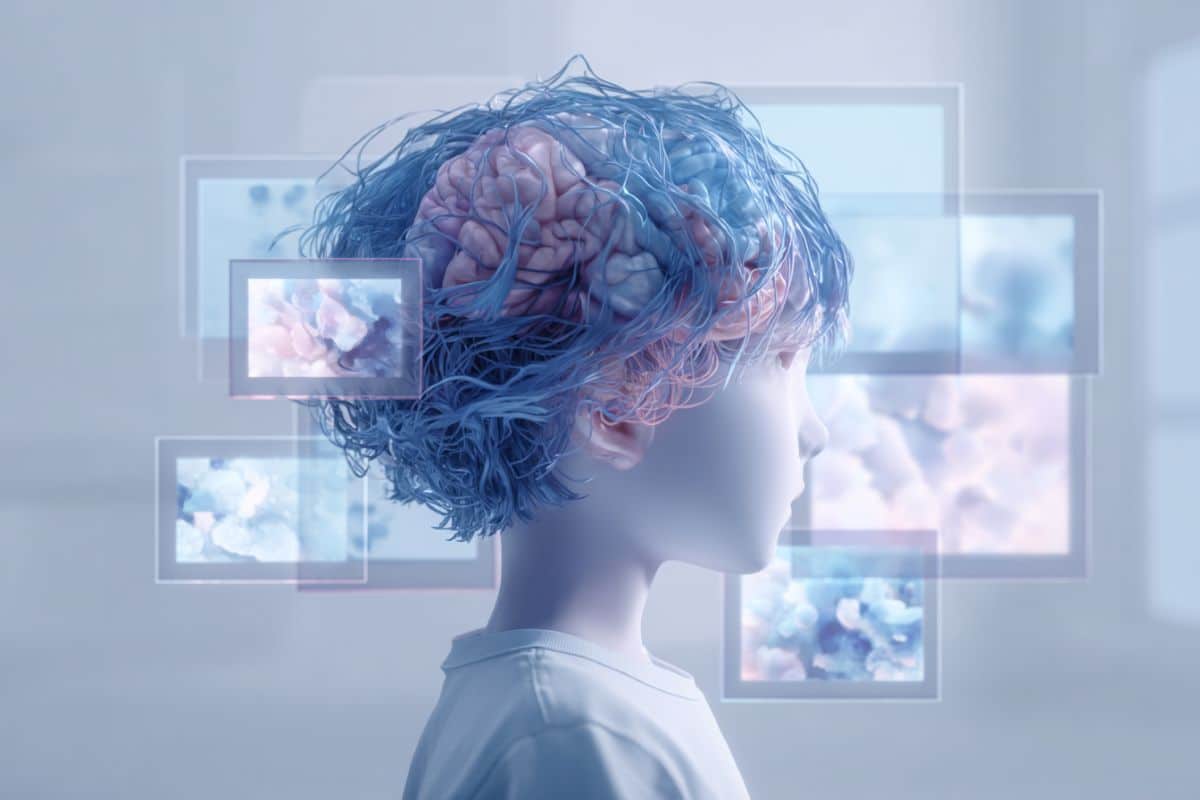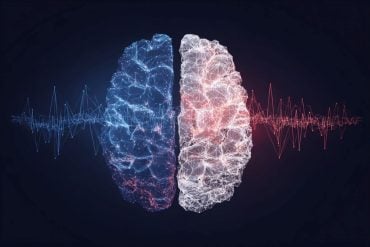Summary: A large, two-year study of nearly 12,000 children found that higher screen time at ages 9–10 predicts an increase in ADHD symptoms, independent of a child’s starting symptom level. Brain imaging revealed that heavy screen use is associated with smaller cortical volume and disrupted development in regions critical for attention, cognition, and reward processing.
These structural differences partly explain why children with more screen exposure show worsening ADHD symptoms over time. The findings provide developmental neuroscience evidence that excessive daily screen time may contribute to delayed brain maturation patterns often observed in ADHD.
Key Facts:
- Developmental Risk: More screen time at ages 9–10 predicted higher ADHD symptoms two years later.
- Brain Structure Impact: Screen exposure was linked to smaller cortical volume and altered growth in frontal and temporal regions.
- Mediation Effect: Cortical volume partially mediated the relationship between screen time and ADHD symptom severity.
Source: University of Fukui
The digital age has fundamentally reshaped childhood, making screens an integral part of learning, socialization, and entertainment. Globally, screen time among adolescents has surged, accelerated by the isolation and remote learning periods during the COVID-19 pandemic.
Although digital screens are essential tools, their excessive use has been linked to problems such as disrupted sleep, reduced physical activity, and behavioral symptoms.

Scientists have pointed out a correlation between higher screen time and more severe attention-deficit/hyperactivity disorder (ADHD) symptoms—a condition marked by difficulties with attention, hyperactivity, and impulse control.
Unfortunately, existing evidence supporting the above correlation was obtained mainly through cross-sectional studies, which can only offer a single ‘snapshot in time’ across the researched population.
Thus, our understanding of whether and how screen time influences the development of ADHD, as well as its underlying neural mechanisms affecting brain development, remains limited.
Aiming to bridge this gap, a research team led by Assistant Professor Qiulu Shou, Assistant Professor Masatoshi Yamashita, and Associate Professor Yoshifumi Mizuno, all affiliated to the University of Fukui, Japan, conducted a large-scale study on the impact of screen time on brain development and ADHD symptoms.
Their study was published in Volume 15 of the journal Translational Psychiatry on October 31, 2025.
The researchers used data from the large-scale Adolescent Brain Cognitive Development study in the United States, tracking 11,878 children initially aged 9 to 10 years over a 2-year period.
“This study is the first to examine the relationship between screen time, ADHD symptoms, and brain structure from a developmental perspective using such a large-scale database,” explains Dr. Shou.
Based on advanced magnetic resonance imaging data and parent-reported behavior assessments, the team carefully analyzed the direct associations between screen time and ADHD symptom severity, its development over 2 years, and the resulting changes in brain structure.
The results provided clear evidence of a developmental link: longer daily screen time at baseline was a significant predictor of increased ADHD symptoms after 2 years, even after controlling for initial symptom severity levels.
Notably, screen time was also associated with developmental abnormalities in multiple key brain structures. At baseline, it was linked to a smaller total volume of the cortex and reduced volume in a region known as the right putamen, which plays a key role in language learning, addiction, and reward-related processes.
After 2 years, screen time was associated with hindered development of cortical thickness in regions vital for cognitive functions, including the right temporal pole and specific areas of the left frontal gyrus.
One of the findings of this study centered on the role of brain structure as a mediator of ADHD symptoms. Statistical analyses suggest that total cortical volume partially mediates the relationship between screen time and ADHD symptoms at baseline.
In essence, this means that the observed association between longer screen time and greater ADHD symptom severity is, at least in part, explained by the observed smaller cortical volume. The team suggests that excessive screen exposure may contribute to a delayed brain maturation pattern that is often observed in children with ADHD.
By providing evidence of a neural mechanism, this study bolsters our understanding of the link between digital habits and behavior in developing children.
“Our work provided some evidence toward growing concern about the association between digital media exposure and children’s mental and cognitive health,” comments Dr. Yamashita. “The results provide some neuroscientific evidences for the need to control screen time.”
Overall, this study adds to the existing literature that strongly suggests reducing screen exposure among school-aged children is pivotal to their development. Dr. Mizuno concludes, “Our findings provide evidence that longer screen time is associated with increased ADHD symptoms and brain structural development. The findings of our research enhance our understanding of the link between screen time and ADHD symptoms, as well as the neural mechanisms underlying ADHD.”
To conclude, this study paves the way for further investigation that may guide both the technology industry and the educational sector toward designing digital environments that support, rather than hinder, children’s cognitive growth.
Funding information
This project was funded by the Japan Society for the Promotion of Science through Grants-in-Aid for Scientific Research (KAKENHI) (Grant numbers: 24K16647, 21K02380), Kawano Masanori Memorial Public Interest Incorporated Foundation for Promotion of Pediatrics (AY 2022), Research Grants from the University of Fukui (AY 2023), and the Life Science Innovation Center, University of Fukui (AY 2023).
Key Questions Answered:
A: Yes. Longer daily screen use at ages 9–10 predicted higher ADHD symptoms two years later, even after accounting for baseline symptom levels.
A: Higher screen time was linked to smaller cortical volume and altered development in regions involved in attention, cognitive control, and reward.
A: Partially. Reduced total cortical volume mediated part of the relationship, suggesting slower brain maturation contributes to symptom increases.
Editorial Notes:
- This article was edited by a Neuroscience News editor.
- Journal paper reviewed in full.
- Additional context added by our staff.
About this ADHD and neurodevelopment research news
Author: Yuuka Kawamoto
Source: University of Fukui
Contact: Yuuka Kawamoto – University of Fukui
Image: The image is credited to Neurosciene News
Original Research: Open access.
“Association of screen time with attention-deficit/hyperactivity disorder symptoms and their development: the mediating role of brain structure” by Masatoshi Yamashita et al. Translational Psychiatry
Abstract
Association of screen time with attention-deficit/hyperactivity disorder symptoms and their development: the mediating role of brain structure
The association among screen time, attention-deficit/hyperactivity disorder (ADHD) symptom development, and brain structure, and the neural mechanisms underlying the association between screen time and ADHD symptoms remain unclear.
This study examines the relationships between the three using large-scale longitudinal data from the Adolescent Brain Cognitive Development (ABCD) study.
Data on screen time, ADHD symptoms (measured via the Child Behavior Checklist), and brain structure were extracted from 10,116 children at baseline (ages 9–10) and 7880 children at a two-year follow-up.
A linear mixed-effects model was used to assess the association between baseline screen time and changes in ADHD symptoms and brain structure after two years.
Additionally, the mediating role of brain structure on the association between screen time and ADHD symptoms was examined.
The results showed that screen time was associated with increased ADHD symptoms (β = 0.032, p = 0.001) and reduced cortical thickness in specific regions (right temporal pole: β = −0.036, false discovery rate (FDR)-corrected p = 0.020; left superior frontal gyrus: β = −0.028, FDR-corrected p = 0.020; and left rostral middle frontal gyrus: β = −0.030, FDR-corrected p = 0.020).
Total cortical volume partially mediated the relationship between screen time and ADHD symptoms (β = 0.001, p = 0.023) at baseline.
These findings suggest that screen time is associated with ADHD symptoms and brain structure, as well as their development, potentially providing insights into the neural mechanisms underlying the association between screen time and ADHD symptomatology.






